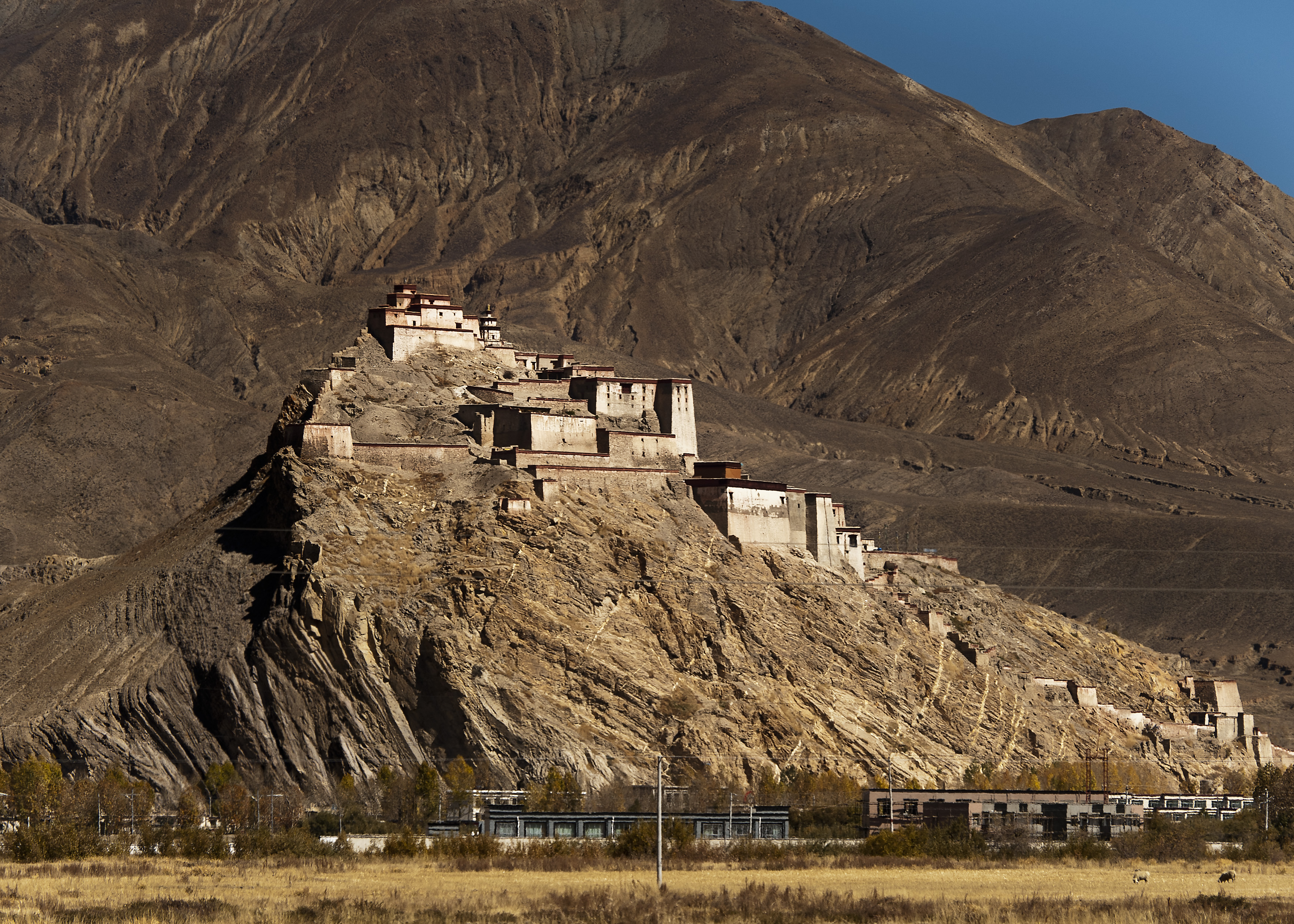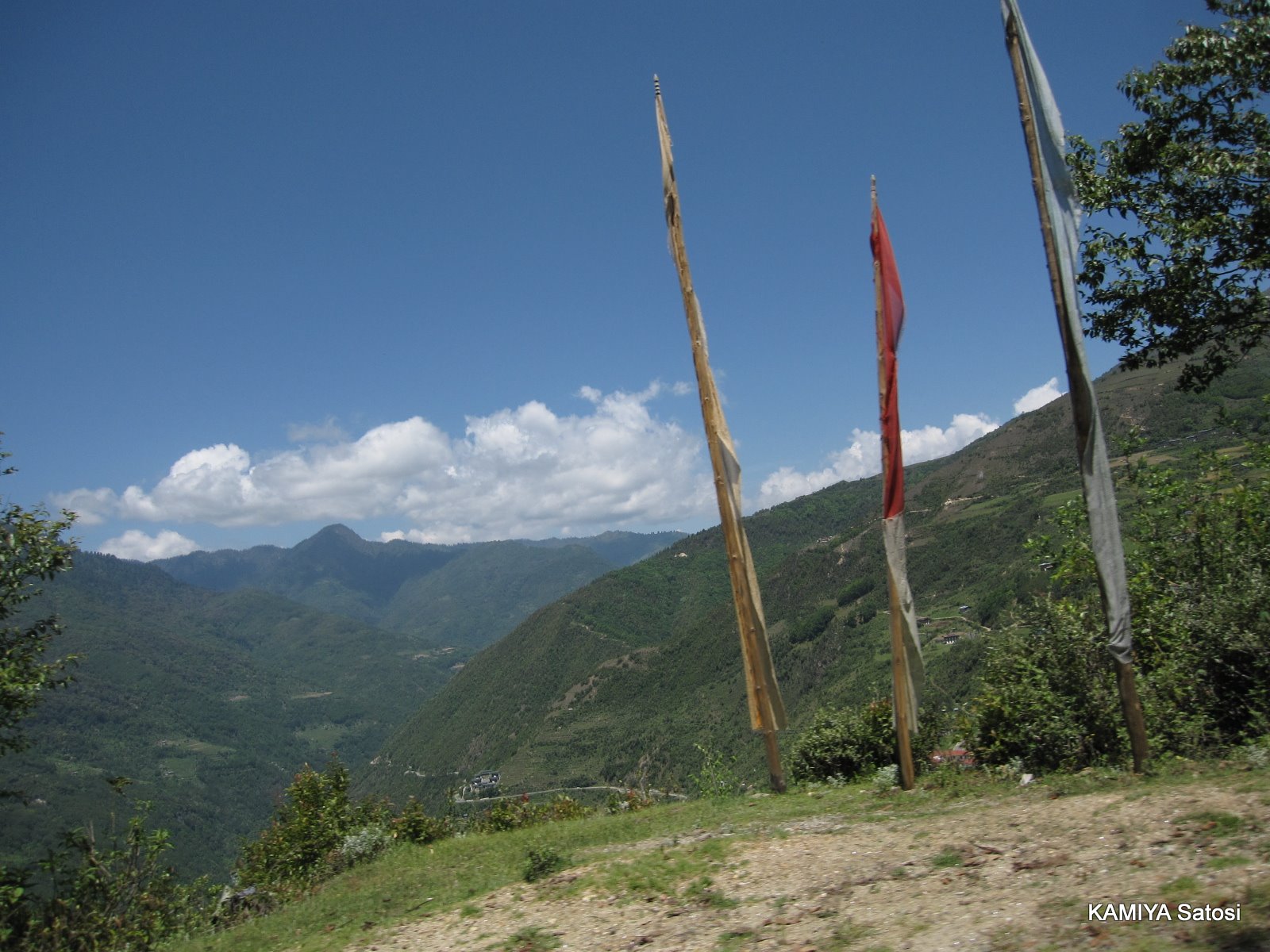|
Thruepang Palace
Thruepang Palace is a royal dzong (a form of fortress) in Trongsa District, Bhutan. The royal government of Bhutan considers it to be a historic building. History Early history Located on the hillside, the palace was considered crucial in establishing control in the early days of the kingdom. The dzong (fortress) portion was constructed in 1648. The first and second kings used the fortress to rule the kingdom from this crucial position. Modern history It is the birthplace of the third Druk Gyalpo (King) Jigme Dorji Wangchuck of Bhutan in 1928. He spent is early days growing up in the palace. This was a secondary resident and served as a, but not main, royal palace for the second Druk Gyalpo (king) Jigme Wangchuck and Queen Ashi Puntsho Choden. The Trhruepang Palace currently is still in use as a winter royal palace for the current king Jigme Khesar Namgyel Wangchuck. It is customary that any and future kings of Bhutan to serve as governor of the village, with his resid ... [...More Info...] [...Related Items...] OR: [Wikipedia] [Google] [Baidu] |
Dzong Architecture
Dzong architecture is used for dzongs, a distinctive type of fortified monastery ( dz, རྫོང, , ) architecture found mainly in Bhutan and Tibet. The architecture is massive in style with towering exterior walls surrounding a complex of courtyards, temples, administrative offices, and monks' accommodation. Characteristics Distinctive features include: * High inward sloping walls of brick and stone painted white with few or no windows in the lower sections of the wall * Use of a surrounding red ochre stripe near the top of the walls, sometimes punctuated by large gold circles * Use of unique style flared roofs atop interior temples * Massive entry doors made of wood and iron * Interior courtyards and temples brightly colored in Buddhist-themed art motifs such as the ashtamangala or swastika Regional differences Bhutan Dzongs serve as the religious, military, administrative, and social centers of their district. They are often the site of an annual ''tsechu'' or religious ... [...More Info...] [...Related Items...] OR: [Wikipedia] [Google] [Baidu] |
Trongsa District
Trongsa District (Dzongkha: ཀྲོང་གསར་རྫོང་ཁག་; Wylie transliteration: ''Krong-gsar rdzong-khag'') is one of the districts of Bhutan. It is the most central district of Bhutan and the geographic centre of Bhutan is located within it at Trongsa Dzong. Languages Trongsa is a linguistically diverse district. In the north and east inhabitants speak Bumthangkha, and in the extreme southeast Khengkha is spoken. Nyenkha is spoken in the western half of the district, straddling the border with Wangdue Phodrang District. To the north, along and across the same border, live speakers of Lakha. In the extreme south, the national language Dzongkha is spoken. Across the mid-south, tiny communities of autochthonous 'Olekha (Black Mountain Monpa) speakers have all but disappeared. Historically, Bumthangkha and its speakers have had close contact with speakers of Kurtöpkha, Mangduepikha and Khengkha, nearby languages of central and eastern Bhutan, to the exten ... [...More Info...] [...Related Items...] OR: [Wikipedia] [Google] [Baidu] |
Bhutan
Bhutan (; dz, འབྲུག་ཡུལ་, Druk Yul ), officially the Kingdom of Bhutan,), is a landlocked country in South Asia. It is situated in the Eastern Himalayas, between China in the north and India in the south. A mountainous country, Bhutan is known as "Druk Yul," or "Land of the Thunder Dragon". Nepal and Bangladesh are located near Bhutan but do not share a land border. The country has a population of over 727,145 and territory of and ranks 133rd in terms of land area and 160th in population. Bhutan is a Constitutional Democratic Monarchy with King as head of state and Prime Minister as head of government. Mahayana and Vajrayana Buddhism is the state religion and the Je Khenpo is the head of state religion. The subalpine Himalayan mountains in the north rise from the country's lush subtropical plains in the south. In the Bhutanese Himalayas, there are peaks higher than above sea level. Gangkhar Puensum is Bhutan's highest peak and is the highest uncl ... [...More Info...] [...Related Items...] OR: [Wikipedia] [Google] [Baidu] |
Druk Gyalpo
The Druk Gyalpo (; 'Dragon King') is the head of state of the Bhutan, Kingdom of Bhutan. In the Dzongkha, Dzongkha language, Bhutan is known as ''Drukyul'' which translates as "The Land of the Thunder Dragon". Thus, while kings of Bhutan are known as ''Druk Gyalpo'' ("Dragon King"), the Bhutanese people call themselves the ''Drukpa'', meaning "people of Druk (Bhutan)". The current sovereign of Bhutan is Jigme Khesar Namgyel Wangchuck, the fifth ''Druk Gyalpo''. He wears the Raven Crown, which is the official crown worn by the kings of Bhutan. He is correctly styled "''Mi'wang 'Ngada Rinpoche''" ("His Majesty") and addressed "''Ngada Rimboche''" ("Your Majesty"). King Jigme Khesar was the second-youngest reigning monarch in the world when he ascended the throne on 1 November 2008 after his father, Jigme Singye Wangchuck, abdicated the throne in his favour. Duties and powers The Constitution confirms the institution of monarchy. The Druk Gyalpo (King of Bhutan) is the head of ... [...More Info...] [...Related Items...] OR: [Wikipedia] [Google] [Baidu] |
Jigme Dorji Wangchuck
Jigme Dorji Wangchuck ( dz, འབྲུག་རྒྱལ་པོ་ འཇིགས་མེད་རྡོ་རྗེ་དབང་ཕྱུག་མཆོག་, ; 2 May 1928 – 21 July 1972) was the 3rd Druk Gyalpo of Bhutan. He began to open Bhutan to the outside world, began modernization, and took the first step towards democratization. Early life Jigme Dorji Wangchuck was born in 1928 in Thruepang Palace in Trongsa. At a young age, he was apprenticed in etiquette and leadership at the royal court of his father the King. Wangchuck was educated in a British manner in Kalimpong and went on study tours and stay to many foreign countries such as Scotland and Switzerland from where he drew inspiration to develop Bhutan with suitable adaptations. In 1943, he was appointed Trongsa '' Dronyer'' and then elevated as the 25th Paro ''Penlop'' in 1950, upon the death of the 24th Paro ''Penlop'', Tshering Penjor (1902–1949). Wangchuck married ''Ashi'' Kesang Choden Wangchuc ... [...More Info...] [...Related Items...] OR: [Wikipedia] [Google] [Baidu] |
Jigme Wangchuck
Jigme Wangchuck ( dz, འཇིགས་མེད་དབང་ཕྱུག, ; 1905 – 30 March 1952) was the 2nd Druk Gyalpo or king of Bhutan from 26 August 1926, until his death. He pursued legal and infrastructural reform during his reign. Bhutan continued to maintain almost complete isolation from the outside world during this period; its only foreign relations were with the British Raj in India. He was succeeded by his son, Jigme Dorji Wangchuck. Early life Jigme Wangchuck was born in 1905, at the Thinley Rabten Palace in Wangdue Phodrang District. He received his education at Wangdecholing Palace, where he learned English and Hindi and received a religious education.Lham Dorji, p. 30 As the first son of Ugyen Wangchuck, Jigme was expected to succeed his father; accordingly, he was given the title Penlop of Trongsa in 1923.Lham Dorji, p. 31 Reign Jigme Wangchuck ascended to the throne in 1926, after the death of Ugyen Wangchuck; he received his formal coronation in Puna ... [...More Info...] [...Related Items...] OR: [Wikipedia] [Google] [Baidu] |
Ashi Puntsho Choden
Ashi (Avestan: 𐬀𐬴𐬌 ''aṣ̌i/arti'') is the Avestan language word for the Zoroastrian concept of "that which is attained." As the hypostasis of "reward," "recompense," or "capricious luck," ''Ashi'' is also a divinity in the Zoroastrian hierarchy of ''yazata''s. Nomenclature Avestan 'ashi' is a feminine abstract noun, deriving from the root ''ar-'', "to allot," with a substantivizing ''-ta'' suffix, hence ''aṣ̌i/arti'' "that which is granted." In the Avesta, the term implies both material and spiritual recompense. Although conceptually older than Zoroastrianism, Ashi has no attested equivalent in Vedic Sanskrit. The late Middle Persian equivalent as attested in the Zoroastrian texts of the 9th-12th century is ''ard-'', which is subject to confusion with another ''ard'' for '' aṣ̌a/arta-'' "truth". In the younger Avesta, divinified ''Ashi'' is also referred to Ashi Vanuhi or Ashi Vanghuhi (''Aši vaηuhī'', nominative ''Ašiš vaηuhī'' "Good Reward"), the Midd ... [...More Info...] [...Related Items...] OR: [Wikipedia] [Google] [Baidu] |
Jigme Khesar Namgyel Wangchuck
Jigme Khesar Namgyel Wangchuck ( dz, འཇིགས་མེད་གེ་སར་རྣམ་རྒྱལ་དབང་ཕྱུག་, ; born 21 February 1980) is the Druk Gyalpo ( Dzongkha: Dragon King) of the Kingdom of Bhutan. After his father Jigme Singye Wangchuck abdicated the throne in his favor, he became the monarch on 9 December 2006. A public coronation ceremony was held on 6 November 2008, a year that marked 100 years of monarchy in Bhutan. Early life and education Khesar was born 21 February 1980 at Paropakar Maternity and Women's Hospital in Kathmandu. He is the eldest son of the fourth Dragon king of Bhutan, Jigme Singye Wangchuck, and his third wife, Queen ''Ashi'' Tshering Yangdon. He has a younger sister, Princess ''Ashi'' Dechen Yangzom, and brother, Prince ''Gyaltshab'' Jigme Dorji, as well as four half-sisters and three half-brothers. After completing his higher secondary studies at Yangchenphug High School, Khesar was educated in the United States ... [...More Info...] [...Related Items...] OR: [Wikipedia] [Google] [Baidu] |
Nubi Gewog
Nubi Gewog (Dzongkha: ནུ་སྦིས་) is a gewog (village block) of Trongsa District, Bhutan Bhutan (; dz, འབྲུག་ཡུལ་, Druk Yul ), officially the Kingdom of Bhutan,), is a landlocked country in South Asia. It is situated in the Eastern Himalayas, between China in the north and India in the south. A mountainous .... References Gewogs of Bhutan Trongsa District {{coord missing, Bhutan ... [...More Info...] [...Related Items...] OR: [Wikipedia] [Google] [Baidu] |
Gewogs Of Bhutan
A gewog ( dz, རྒེད་འོག ''geok'', block), in the past also spelled as geog, is a group of villages in Bhutan. The head of a ''gewog'' is called a ''gup'' ( ''gepo''). Gewogs form a geographic administrative unit below dzongkhag districts (and dungkhag subdistricts, where they exist), and above Dzongkhag Thromde class B and Yenlag Thromde municipalities. Dzongkhag Thromde class A municipalities have their own independent local government body. Bhutan comprises 205 gewogs, which average in area. The gewogs in turn are divided into chewogs for elections and thromdes "municipalities" for administration. The Parliament of Bhutan passed legislation in 2002 and 2007 on the status, structure, and leadership of local governments, including gewogs. The most recent legislation by parliament regarding gewogs is the Local Government Act of Bhutan 2009. In July 2011, the government slated 11 gewogs across Bhutan for reorganization, including both mergers and bifurcations, to b ... [...More Info...] [...Related Items...] OR: [Wikipedia] [Google] [Baidu] |
Tshechu
A tshechu ( dz, ཚེས་བཅུ།, literally "day ten") is any of the annual religious Bhutanese festivals held in each district or dzongkhag of Bhutan on the tenth day of a month of the lunar calendar, lunar Tibetan calendar. The month depends on the place. Tshechus are religious festivals of the Drukpa Lineage of the Kagyu school of Tibetan Buddhism. Tshechus are large social gatherings, which perform the function of social bonding among people of remote and spread-out villages. Large markets also congregate at the fair locations, leading to brisk commerce.Dancing on the demon's back: the dramnyen dance and song of Bhutan by Elaine Dobson, John Blacking Symposium: Music Culture and Society, Callaway Centre, University of Western Aust ... [...More Info...] [...Related Items...] OR: [Wikipedia] [Google] [Baidu] |



